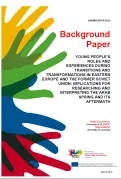Young People’s Roles and Experiences During Transitions and Transformations in Eastern Europe and the Former Soviet Union

SAHWA Background Paper, nº. 6
This paper is framed by Karl Mannheim’s theory about political generations. The paper opens with how Mannheim’s ideas have been built upon since his lifetime, and uses the post-1945 baby boom generation and its student movements of the 1960s as an example of the formation and maturation of a political generation. We then discuss the series of revolutions and mass protests in Eastern Europe beginning in 1989. These are divided into the ‘velvet’ (peaceful) revolutions, change in Serbia and the West Balkans, and the ‘colour revolutions’ and other uprisings since 2000. We examine young people’s roles in these events, the effects among young people of any ensuing changes, and the character of new political generations that have been formed. The paper concludes with a series of points to be addressed in future research. These include the need to distinguish between young people who were politically aware and active before, during and soon after a revolutionary event, and the young people who have become politically aware and (in some cases) active subsequently.